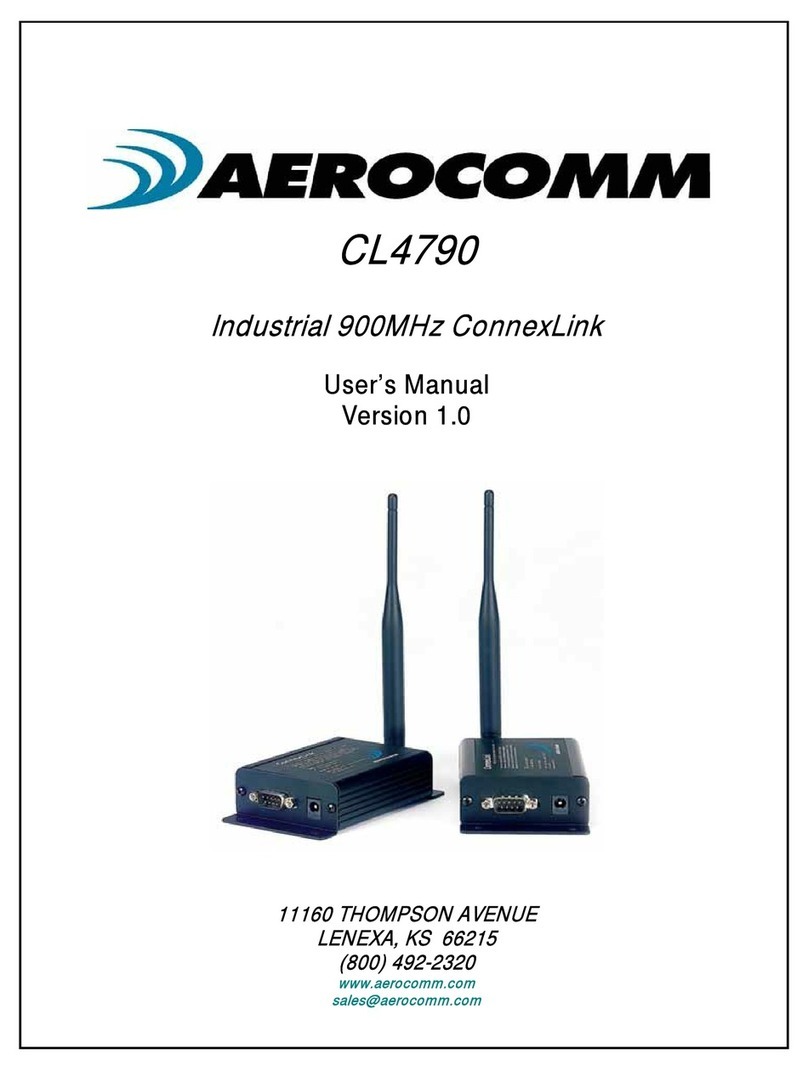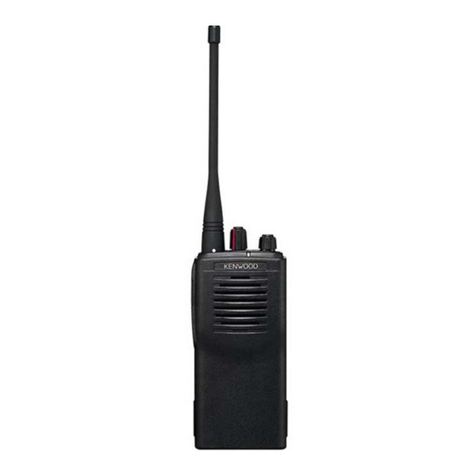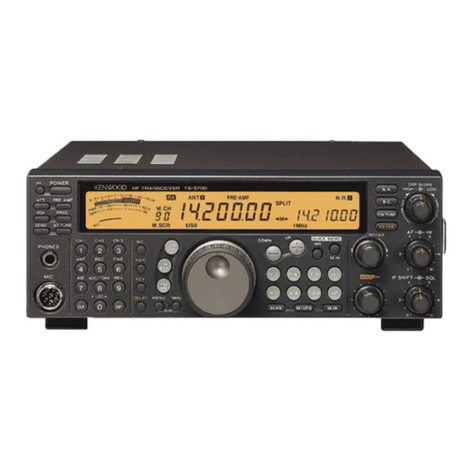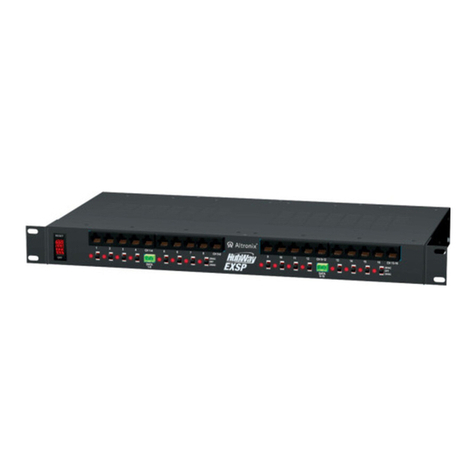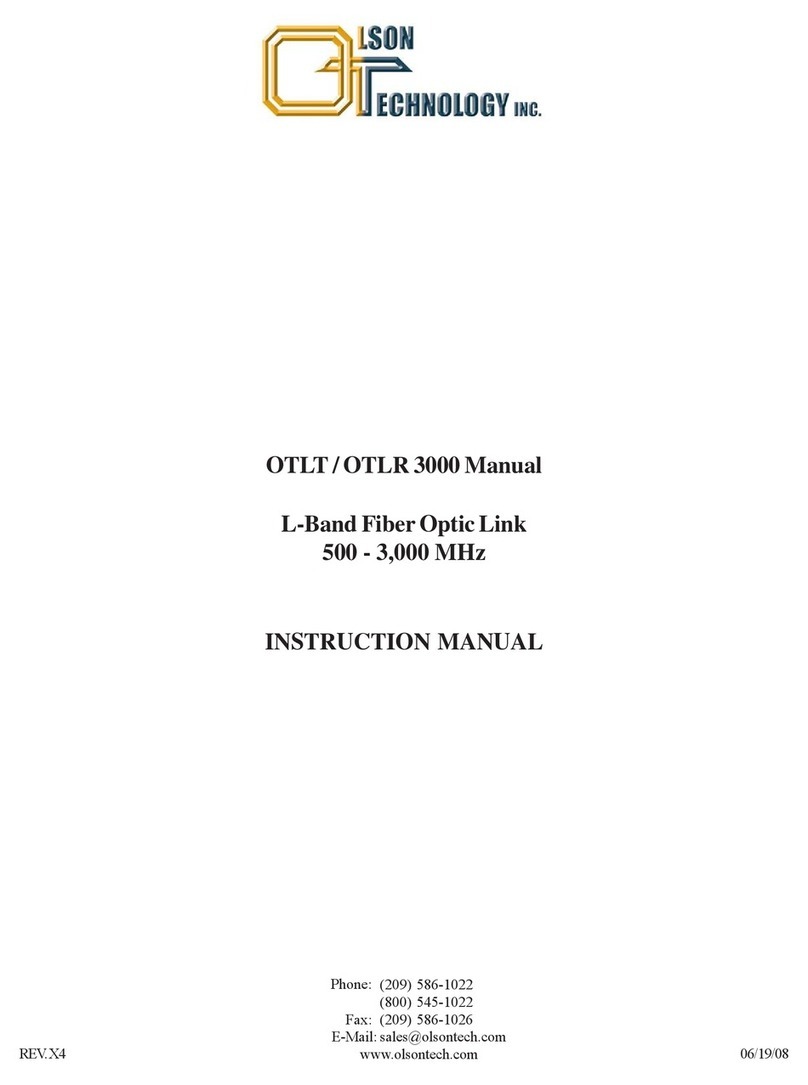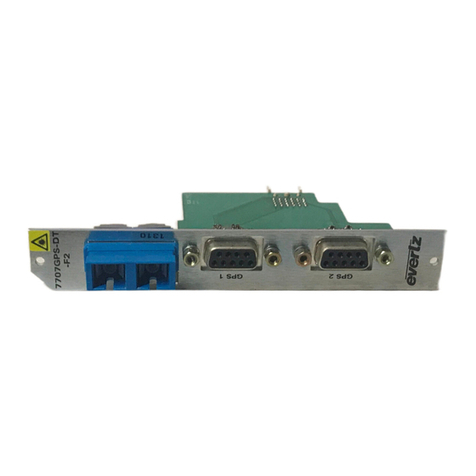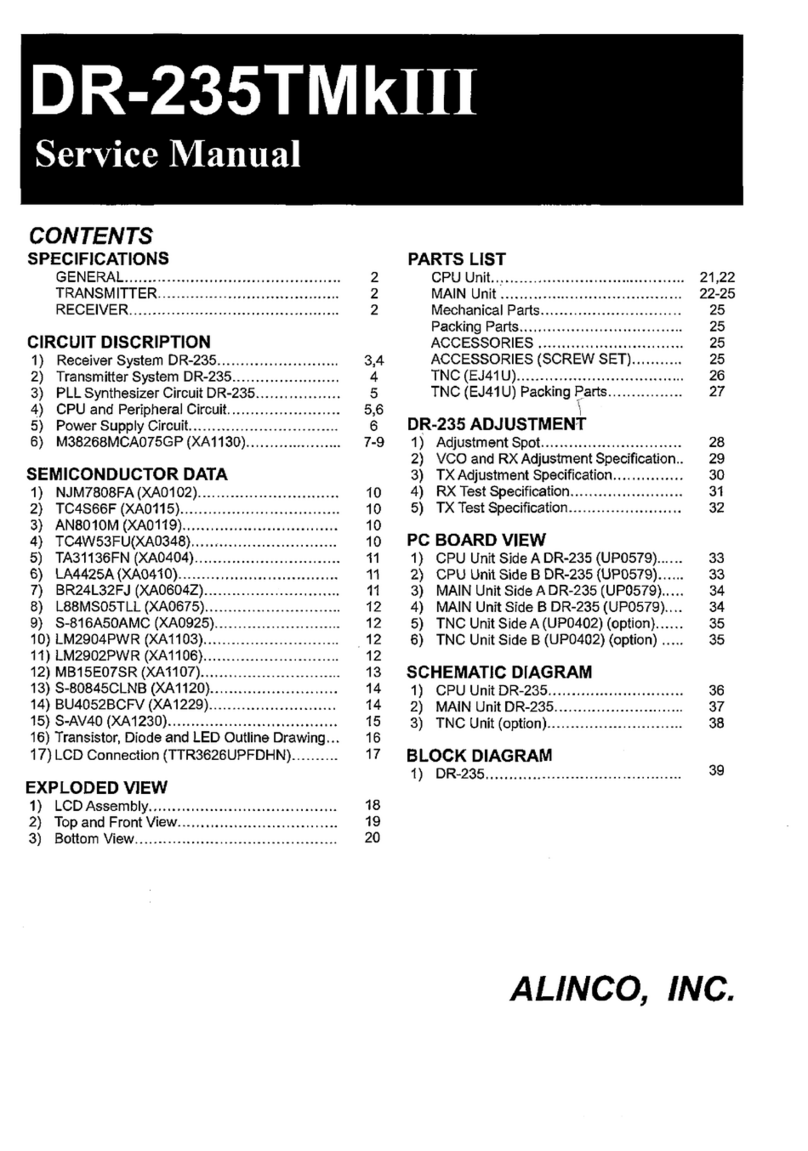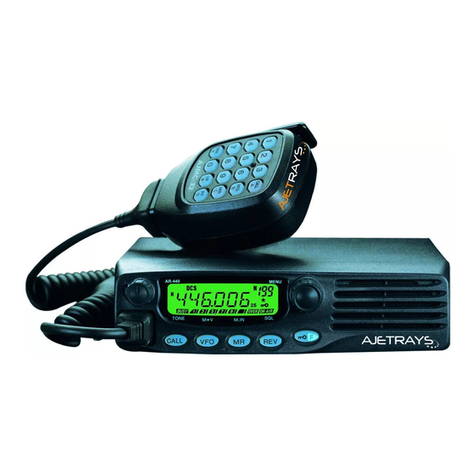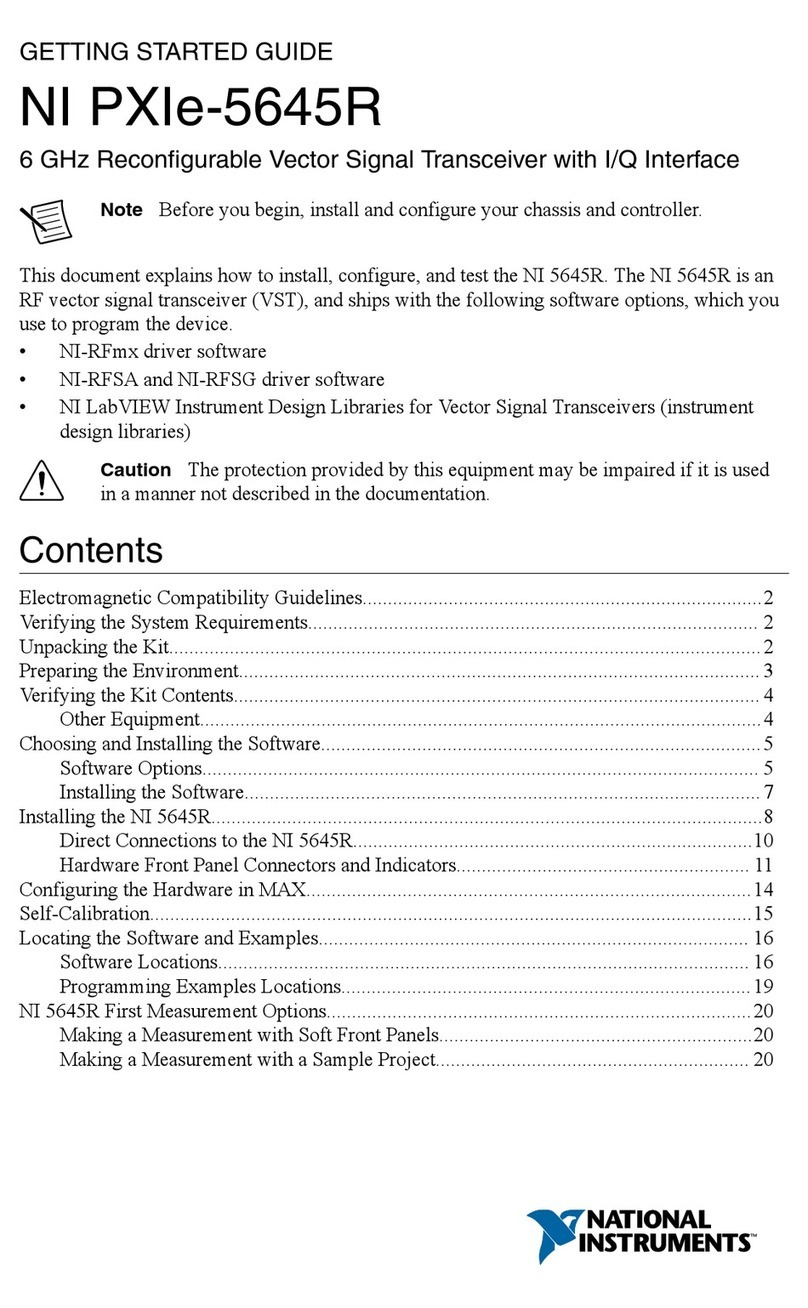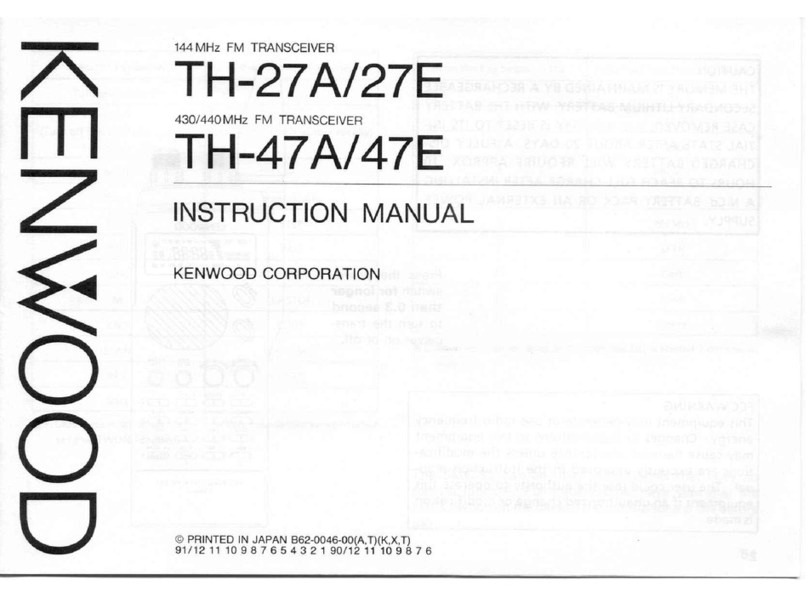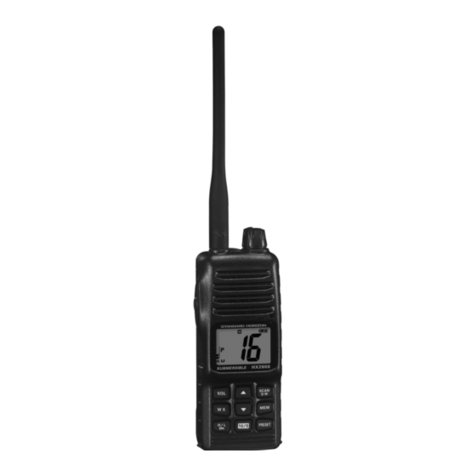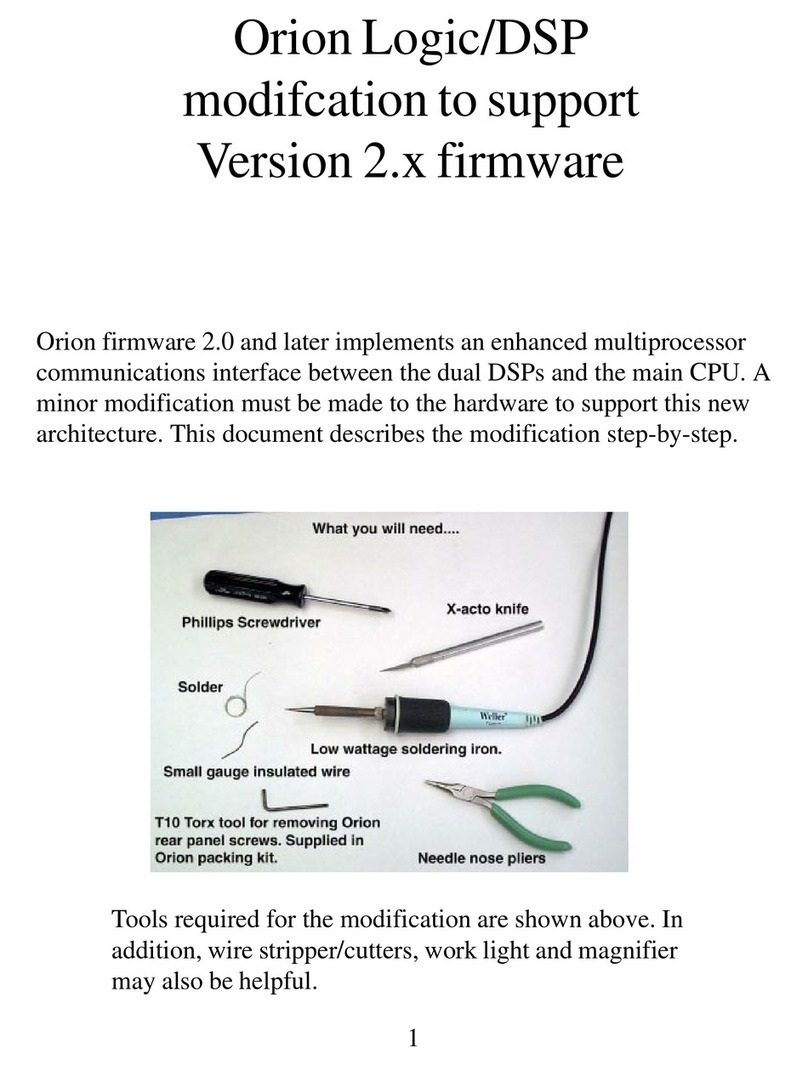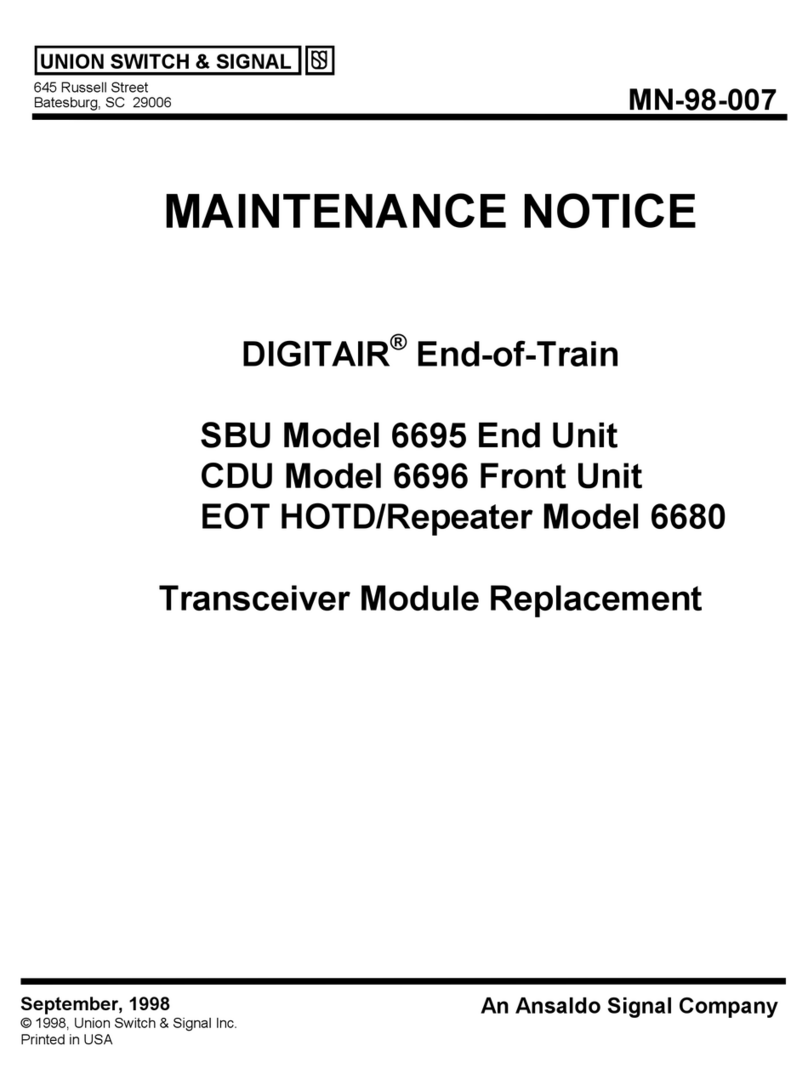AeroComm PKLR2400S User manual

10/20/00 2
DOCUMENT INFORMATION
Copyright
Information
Copyright © 2000 AEROCOMM, Inc. All rights reserved.
The information contained in this manual and the accompanying
software programs are copyrighted and all rights are reserved by
AEROCOMM, Inc. AEROCOMM, Inc. reserves the right to make
periodic modifications of this product without obligation to notify
any person or entity of such revision. Copying, duplicating, selling, or otherwise
distributing any part of this product without the prior consent of an authorized
representative of AEROCOMM, Inc. is prohibited.
All brands and product names in this publication are registered
trademarks or trademarks of their respective holders.
Revision Description
Version 1.0 2/4/99 –Initial Release Version
Version 1.1 Page 24 -System ID Address corrected from 30h to 34h
Version 2.0 5/25/1999 –Add transparent serial modes
Add EEPROM Write Protect
Changed Pin 27 Definition to Forced API Mode 03
Version 3.0 6/10/1999 –Add broadcast packet attempts
Broadcast packet size increased from 256Bytes to 2 KBytes
Version 3.1 7/22/1999 –Correct number of channels from 75 to 77
Change nomenclature for Serial Packet Mode 03 to Serial API Mode 03
Version 3.2 10/15/1999 –Updated FCC Statement
Version 3.3 10/22/1999 –Update FCC Antenna and Labeling requirements
Add baud rate of 38.4kbps
Version 3.4 11/22/1999 –Add DOS S/W programming switch to Serial Adapter Board
Add RSSI to pin 11
Change PKTMODE from pin 27 to Pin 2
Revise checksum definition in Command Set
Add requirement for RTS
Add Modem Modes
Add Power Down Modes
Version 3.5 1/24/2000 –Add In-Range Signal to Pin 15
Add CSMA/Turbo Modes
Version 3.6 Remove SDK developer kit information –6/6/00
Re-arrange the layout of the specification to ease use
Correct Channels from 75 to 77 and provide range in Hex, Section 5.1.3
Version 3.7 6/28/00 –Made data rates uniform at 882Kbps
Reformat I/O table to view additional line descriptions
Version 3.8 8/18/00 –Changed Input Voltage tolerance from 5% to 2%
Changed temperature from 0 –60 °C to 0 –70 °C
Changed Baud Low Default from F7 to F1
Updated Section 6 –API Command Set with examples & corrections
Added pin notations on Figure 1 -Mechanical Overview of PKLR2400S
Version 3.9 9/25/00 –Corrected DTR pin number from 33 to 34, pin 33 is NC
Changed pin 24 from Reserved to NC
Remove Note from the CTS timing diagram in Sections 3.3.1 & 4.6
Changed description for Diagnostic Result* command in section 6.1.3
Downloaded from Arrow.com.Downloaded from Arrow.com.

10/20/00 3
DOCUMENT INFORMATION
This material is preliminary
Information furnished by AEROCOMM in this specification is believed to be accurate. Devices
sold by AEROCOMM are covered by the warranty and patent indemnification provisions
appearing in its Terms of Sale only. AEROCOMM makes no warranty, express, statutory, and
implied or by description, regarding the information set forth herein. AEROCOMM reserves the
right to change specifications at any time and without notice.
AEROCOMM’s products are intended for use in normal commercial applications. Applications
requiring extended temperature range or unusual environmental requirements such as
military, medical life-support or life-sustaining equipment are specifically not recommended
without additional testing for such application.
Downloaded from Arrow.com.Downloaded from Arrow.com.Downloaded from Arrow.com.

10/20/00 4
FCC INFORMATION
Agency Approval Overview
Part Number US/FCC CAN/IC EUR/EN Portable Mobile Fixed
PKLR2400S-10 XXXXXX
Note: The product approval above is with antennas specified below.
FCC Notice
Antenna Warning
Approved Antenna List
Mfr Model Freq Gain Type Connector Dimensions
1Centurion(1) WCP-2400-MMCX 2.4-2.5 2dBi Omni MMCX <2.25"
2Maxrad MFB24008RPN 2.4-2.5 8dBi Omni R-N-F17"
3Maxrad BMMG24000MSMARP12' 2.4-2.5 Unity Omni-mobile R-SMA-M1.75"
4Maxrad BMMG24005MSMARP12' 2.4-2.5 5dBi Omni-mobile R-SMA-M9"
5AeroComm NZH2400 2.4-2.5 1dBi Omni Integrated 1"x0.3"
6Maxrad MP24013TMSMARP12 2.4-2.5 13dBi Panel R-SMA-M8.7x7.9x1.1
7Maxrad MUF24005M174MSMARP12 2.4-2.5 5dBi Omni-Mobile R-SMA-M8.75"
8Centurion(2) WCR-2400-SMRP 2.4-2.5 2dBi Omni R-SMA-M<2.25"
Note: R-XX implies a reverse polarity connector
(1) Previous P/N: WXE2400
(2) Previous P/N: WXR2400SMRP
WARNING: This device complies with Part 15 of the FCC Rules. Operation is subject to the
following two conditions: (1) This device may not cause harmful in
terference and (2)
This device must accept any interference received, including interference that may
cause undesired operation.
WARNING:
This device has been tested with an MMCX connector with the antennas listed below.
Any antenna not in the following table must be tested to comply with FCC Section
15.203 for unique antenna connectors and Section 15.247 for emissions.
Downloaded from Arrow.com.Downloaded from Arrow.com.Downloaded from Arrow.com.Downloaded from Arrow.com.

10/20/00 5
FCC INFORMATION
Labeling Requirements
RF Exposure
WARNING: The Original Equipment Manufacturer (OEM) must ensure that FCC labeling
requirements are met. This includes a clearly visible label on the outside of the
OEM enclosure specifying the AeroComm FCC identifier, KQL-PKLR2400, for this
product as well as the FCC Notice above.
WARNING TO OEMS: To comply with FCC RF Exposure requirements, the Original Equipment
Manufacturer (OEM) must ensure that Antennas 2, 3, 4, 6 and 7 in the
previous table must be installed and/or configured to operate with a
separation distance of 20cm or more from all persons to satisfy RF
Exposure compliance.
The preceding statement must be included as a CAUTION statement in
manuals for products operating with Antennas 2, 3, 4, 6 and 7 in the
previous table to alert users on FCC RF Exposure compliance.
Downloaded from Arrow.com.Downloaded from Arrow.com.Downloaded from Arrow.com.Downloaded from Arrow.com.Downloaded from Arrow.com.

10/20/00 6
TABLE OF CONTENTS
1. OVERVIEW..........................................................................................................................8
2. PKLR2400S SPECIFICATIONS ..........................................................................................9
3. THEORY OF OPERATION ................................................................................................10
3.1 DEFINITIONS .....................................................................................................................10
3.2 INTERFACE SIGNAL DEFINITIONS..........................................................................................11
3.3 HOST SOFTWARE/HARDWARE INTERFACE DEFINITION ............................................................12
3.3.1 Clear To Send (CTS) ................................................................................................12
3.3.2 Reserved .................................................................................................................12
3.3.3 Baud Rate Selector (BDSEL)....................................................................................12
3.3.4 In-Range ..................................................................................................................12
3.3.5 Received Signal Strength Indicator..........................................................................13
3.3.6 Request To Send (RTS)............................................................................................13
3.3.7 Microprocessor Reset (µP_RESET) ..........................................................................13
3.3.8 EEPROM Write Enable (WR_ENA).............................................................................14
4. SERIAL INTERFACE MODES ...........................................................................................14
4.1 SERIAL INTERFACE MODE 01 –TRANSPARENT, FIXED LENGTH, WITH TIMEOUT..........................14
4.2 SERIAL INTERFACE MODE 02 –TRANSPARENT, END CHARACTER ............................................14
4.3 SERIAL INTERFACE MODE 03 –API......................................................................................15
4.4 SERIAL INTERFACE MODE 04 –TRANSPARENT, FIXED LENGTH, NO TIMEOUT............................15
4.5 SERIAL INTERFACE BUFFER.................................................................................................16
4.6 INITIALIZATION SEQUENCE ..................................................................................................16
5. CONFIGURING THE PKLR2400S.....................................................................................18
5.1 SYSTEM EEPROM PARAMETERS ........................................................................................18
5.1.1 Product Identifier String/Version Information............................................................18
5.1.2 IEEE Assigned MAC Address....................................................................................18
5.1.3 Channel Number......................................................................................................19
5.1.4 Client/Server Mode ..................................................................................................19
5.1.5 System ID.................................................................................................................19
5.1.6 Baud High (BH) and Baud Low (BL) ........................................................................20
5.2 PROTOCOL EEPROM PARAMETERS ....................................................................................21
5.2.1 Transmit Data Link Attempts.....................................................................................22
5.2.2 Receive Mode .........................................................................................................22
5.2.3 In-Range, Out-of-Range Refresh..............................................................................22
5.2.4 End Character Definition..........................................................................................23
5.2.5 Fixed Packet Length High Byte and Low Byte..........................................................23
5.2.6 Serial Interface/Power Down Modes........................................................................24
5.2.7 Destination Address Control ....................................................................................26
5.2.8 Interface Timeout Control ........................................................................................26
5.2.9 Broadcast Attempts..................................................................................................27
5.2.10 RF Mode ..................................................................................................................27
5.3 EEPROM PARAMETER SUMMARY .......................................................................................28
6. API COMMAND SET (SERIAL INTERFACE MODE 03 ONLY) .........................................29
6.1 SYSTEM COMMAND SET SUMMARY......................................................................................29
6.1.1 Reset*......................................................................................................................30
6.1.2 Control*...................................................................................................................30
Downloaded from Arrow.com.Downloaded from Arrow.com.Downloaded from Arrow.com.Downloaded from Arrow.com.Downloaded from Arrow.com.Downloaded from Arrow.com.

10/20/00 7
TABLE OF CONTENTS
6.1.3 Diagnostic Result*...................................................................................................31
6.1.4 Reset EEPROM* ......................................................................................................31
6.1.5 Status Request*.......................................................................................................31
6.1.6 Status Reply*...........................................................................................................32
6.1.7 Update EEPROM Checksum*...................................................................................33
6.1.8 Check EEPROM Checksum*....................................................................................33
6.1.9 EEPROM Checksum Status* ....................................................................................33
6.1.10 Acknowledge* .........................................................................................................34
6.2 TRANSCEIVER COMMAND SET SUMMARY..............................................................................34
6.2.1 RF Enable*...............................................................................................................34
6.2.2 Send Data* ..............................................................................................................35
6.2.3 Send Data Complete*..............................................................................................35
6.2.4 Received Data*........................................................................................................36
6.2.5 In Range*.................................................................................................................36
6.2.6 Out of Range*..........................................................................................................36
6.3 INITIALIZING THE PKLR2400S TRANSCEIVER .........................................................................37
7. MECHANICAL OVERVIEW ...............................................................................................38
8.ORDERING INFORMATION..............................................................................................39
8.1 PRODUCT PART NUMBERS..................................................................................................39
8.2 DEVELOPER KIT PART NUMBERS .........................................................................................39
Downloaded from Arrow.com.Downloaded from Arrow.com.Downloaded from Arrow.com.Downloaded from Arrow.com.Downloaded from Arrow.com.Downloaded from Arrow.com.Downloaded from Arrow.com.

PKLR2400S-10 Specifications
10/20/00 8
1. Overview
This document contains information about the hardware and software interface between an AeroComm
PKLR2400S transceiver and an OEM Host. Information includes the theory of operation, system issues, and
a basic command set for operational control of the system and transceiver.
The transceiver is designed to allow flexibility at the hardware interface level with a minimum number of
actual hardware pins connecting the transceiver and the OEM Host. The transceiver is controlled by a
Dallas 87C520 microcontroller providing program storage. A separate EEPROM provides user configurable
parameter storage.
PKLR2400S transceivers operate in a Point-to-Point or Point-to-Multipoint, Client/Server architecture. One
transceiver is configured as a Server and the others are configured as Clients. Data can be transmitted from
Client to Server or Server to Client, but not from Client to Client, or Server to Server.
There are four different Serial Interface Modes provided by the protocol firmware. These Modes offer
significant flexibility to the OEM, allowing them to provide data in many forms including API, End Character
and Fixed-Length with and without Timeouts.
Downloaded from Arrow.com.Downloaded from Arrow.com.Downloaded from Arrow.com.Downloaded from Arrow.com.Downloaded from Arrow.com.Downloaded from Arrow.com.Downloaded from Arrow.com.Downloaded from Arrow.com.

PKLR2400S-10 Specifications
10/20/00 9
2. PKLR2400S Specifications
GENERAL
Bus Interface Serial (TTL Level Asynchronous) or Parallel through 40 pin mini
connector. AMP P/N 177986-1
Interface Data Rate
Serial
Parallel
Programmable to 882Kbps. PC rates to 57.6 Kbps
4 Mbps
Compliance Certifiable under:
US –FCC 15.247
Canada –IC
Europe –EN
Power Consumption
TX/RX Active (All Modes)
Interface ON/RF OFF (API Mode Only)
Sleepwalk (All Modes)
Standby (API Mode Only)
115mA/115mA typical
45mA typical
25mA typical
20mA typical
Channels Supports 77 non-interfering channels
Security User assigned System ID. Unique IEEE addresses on each
transceiver.
TRANSCEIVER
Frequency Band 2.402 –2.478 GHz
Transceiver Type Spread Spectrum Frequency Hopping
Output Power 10mW
Input Voltage 5V nominal +2%, +50mV ripple
Sensitivity -90dBm
Data Rate 882Kbps
Range Indoors up to 300 ft., Outdoors up to 3,000 ft.
Can be extended with directional antenna
ENVIRONMENTAL
Temperature (Operating) 0 °C to +70 °C
Temperature (Storage) -50 °C to +85 °C
Humidity (non-condensing) 10% to 90%
PHYSICAL
Dimensions 1.65” x 2.65” x 0.20”
Antenna Connector Standard MMCX jack
Weight Less than 0.5 ounce
SOFTWARE
User Configurable Options
Host Interface Data Rate Up to 882Kbps
Variable Packet Length Up to 2 KByte
Serial Interface Modes (3) Transparent and (1) API
Diagnostic Error Counters API mode
User Programmable Attempts Up to 255
Downloaded from Arrow.com.Downloaded from Arrow.com.Downloaded from Arrow.com.Downloaded from Arrow.com.Downloaded from Arrow.com.Downloaded from Arrow.com.Downloaded from Arrow.com.Downloaded from Arrow.com.Downloaded from Arrow.com.

PKLR2400S-10 Specifications
10/20/00 10
3. Theory of Operation
The PKLR2400S has a serial interface that allows the OEM Host to send and receive communications to and
from the transceiver. All I/O is 5Vdc TTL level signals except for RSSI, which is an analog output. All outputs
are weakly pulled logic High (20 k –50 k) when left unconnected and are driven logic high at reset.
3.1 DEFINITIONS
Server Host:The Server Host is the OEM device controlling the Server transceiver.
Client Host: The Client Host is the OEM device controlling the Client transceiver.
Host: Host refers to both the Server Host and the Client Host.
Server Transceiver: The Server transceiver is the “Master” transceiver. It is the hub of all
communications.
Client Transceiver: The Client transceiver is a “Slave” transceiver. It is controlled by it’s own
Host, but is a slave to the Server transceiver.
Authentication: The acquisition of a Server IEEE 802.3 address by a Client transceiver and a
subsequent issue of an In-Range* command by the Client transceiver to the Client Host.
Unicast Address: A frame that is directed to a single recipient as specified in IEEE 802.3.
Broadcast Address: A frame that is directed to multiple recipients as specified in IEEE 802.3.
Downloaded from Arrow.com.Downloaded from Arrow.com.Downloaded from Arrow.com.Downloaded from Arrow.com.Downloaded from Arrow.com.Downloaded from Arrow.com.Downloaded from Arrow.com.Downloaded from Arrow.com.Downloaded from Arrow.com.Downloaded from Arrow.com.

PKLR2400S-10 Specifications
10/20/00 11
3.2 INTERFACE SIGNAL DEFINITIONS
The following pinout is for the 40-pin mini-connector, J1 (AMP P/N 177986-1). I/O direction is with regard to
the transceiver.
Table 1. Transceiver Interface Signal Definitions
Pin Type Signal Name Function
1GND GND Signal Ground
2IPKTMODE API Mode -When active (Active Low), the transceiver is forced into API Mode 3
3VCC VCC 5V +2%
4NC NC No Connect
5VCC VCC 5V +2%
6NC NC No Connect
7NC NC No Connect
8NC NC No Connect
9NC NC No Connect
10 NC NC No Connect
11 ORSSI Received Signal Strength -An analog output giving a relative indication of received
signal strength while in receive mode.
12 NC NC No Connect
13 NC NC No Connect/Data 7
14 OTXD Transmitted data out of the transceiver
15 OIn-Range In-Range -Provides a logic low signal when the Client detects a master with the same
System ID and Channel. This pin is active only in Transparent Serial Interface Modes 1,
2 and 4.
16 IRXD Data input to the transceiver
17 IRI_IN Ring Indicator to communicate to modem
18 NC NC No Connect
19 ORI_OUT Ring Indicator to communicate to computer
20 GND GND Ground
21 GND GND Ground
22 IDCD_IN Data Carrier Detect to communicate to modem
23 OCTS Clear to Send –Active Low when the transceiver is ready to accept data for transmission.
24 NC NC No Connect
25 Reserved Reserved Reserved
26 IBDSEL Baud Select –Take this pin active (Active Low) to force the transceiver into a known
serial interface baud rate (9600 8-N-1)
27 IRTS RTS -MUST BE LOW TO ALLOW THE HOST TO RECEIVE DATA FROM THE
PKLR2400S.
28 NC NC No Connect
29 NC NC No Connect
30 NC NC No Connect
31 NC NC No Connect
32 ODSR Data Set Ready
33 NC NC No Connect
34 IDTR Data Terminal
35 NC NC No Connect
36 ODCD_OUT Data Carrier Detect to communicate to computer
37 IWR_ENA EEPROM Write Enable –Enabled when pin 37 is logic low. Pin 37 must be
logic low to Write to the EEPROM.
Note: The transceiver should NOT be write-enabled during the initial power
up or upon a hardware reset to ensure the integrity of the EEPROM data.
38 IµP _RESET Microprocessor Reset –The transceiver is reset by holding pin 38 logic high for a
minimum of 2ms. If a reset is performed after power has been applied to the transceiver
and is stable, the reset time will be significantly less. At all other times, pin 38 should be
logic low. If pin 38 is not connected, the microprocessor will hold pin 38 at logic low.
39 VCC VCC 5V +2%
40 GND GND Signal Ground
I = Input to the transceiver
O = Output from the transceiver
Downloaded from Arrow.com.Downloaded from Arrow.com.Downloaded from Arrow.com.Downloaded from Arrow.com.Downloaded from Arrow.com.Downloaded from Arrow.com.Downloaded from Arrow.com.Downloaded from Arrow.com.Downloaded from Arrow.com.Downloaded from Arrow.com.Downloaded from Arrow.com.

PKLR2400S-10 Specifications
10/20/00 12
3.3 HOST SOFTWARE/HARDWARE INTERFACE DEFINITION
3.3.1 Clear To Send (CTS)
CTS requires a minimum delay of 40µs between (1) and (2) after the end of each data packet.
Figure 1. Timing for CTS Pin
3.3.2 Reserved
Reserved pins are used for internal testing and/or future transceiver enhancements. These pins must be left
floating and not connected to logic high or low.
3.3.3 Baud Rate Selector (BDSEL)
The Baud Rate Selector (BDSEL) provides the OEM a default method of communicating with the
transceiver in the event the EEPROM baud rate parameters become corrupted. If pin 26 is logic high or not
connected, the baud rate will default to that specified in EEPROM. If pin 26 is logic low at RESET, the baud
rate will default to 9600 baud.
3.3.4 In-Range
The In-Range pin will be driven logic low when a Client is in range of a Server on the same Channel and
System ID. If the Client cannot hear a Server for the amount of time that is programmed (Range refresh
time) in the EEPROM, the Client drives the In-Range pin logic high and enters a search mode looking for a
Server. As soon as it detects a Server, the In-Range pin will be driven logic low.
CTS from
transceiver
Delay for reply command
TXD –LSB first
from Host
Command Length ChecksumData
(1) (2)
Downloaded from Arrow.com.Downloaded from Arrow.com.Downloaded from Arrow.com.Downloaded from Arrow.com.Downloaded from Arrow.com.Downloaded from Arrow.com.Downloaded from Arrow.com.Downloaded from Arrow.com.Downloaded from Arrow.com.Downloaded from Arrow.com.Downloaded from Arrow.com.Downloaded from Arrow.com.

PKLR2400S-10 Specifications
10/20/00 13
3.3.5 Received Signal Strength Indicator
The Received Signal Strength Indicator is used by the Host to determine the instantaneous signal strength
at the receiver. The Host must calibrate RSSI without a signal being presented to the receiver. Figure 1
shows approximate RSSI performance. The RSSI pin requires the Host to provide a 27k pull-down to
ground. Output is 1.20V to 5.0V.
3.3.6 Request To Send (RTS)
When the RTS bit is enabled (bit 3 of the Serial Interface/Power Down Mode Byte at EEPROM address
location 4Ah), pin 27 (RTS) must be logic low to allow the Host to receive data from the transceiver.
3.3.7 Microprocessor Reset (µP_RESET)
Microprocessor Reset (µP_RESET) is achieved by holding pin 38 at logic high for a minimum of 2ms. If
µP_RESET is performed after power has been applied to the transceiver and is stable, the reset time will be
significantly less. At all other times, pin 38 should be logic low. If pin 38 is not connected, the
microprocessor will hold pin 38 at logic low.
Figure 1 - RSSI Voltage vs. Received Signal Strength
-100
-90
-80
-70
-60
-50
-40
-30
-20
-10
0
1.2 1.3 1.57 2.3 3.8 4.5
Voltage (VDC)
Signal at Receiver (dBm)
Downloaded from Arrow.com.Downloaded from Arrow.com.Downloaded from Arrow.com.Downloaded from Arrow.com.Downloaded from Arrow.com.Downloaded from Arrow.com.Downloaded from Arrow.com.Downloaded from Arrow.com.Downloaded from Arrow.com.Downloaded from Arrow.com.Downloaded from Arrow.com.Downloaded from Arrow.com.Downloaded from Arrow.com.

PKLR2400S-10 Specifications
10/20/00 14
3.3.8 EEPROM Write Enable (WR_ENA)
EEPROM Write Enable (WR_ENA) is enabled when pin 37 is logic low. Pin 37 must be logic low to write to
the EEPROM.
Note: The OEM must ensure the transceiver is NOT write-enabled during initial power up or during
a hardware RESET. Failure to do so may result in corruption of important EEPROM data.
4. Serial Interface Modes
The PKLR2400S provides four different Serial Interface Modes that can be configured for maximum system
optimization. These Modes include three Transparent modes and one API mode. The transceiver-to-
transceiver protocol is identical for all three Transparent Modes. This allows all three Transparent Modes to
coexist within the same network. The API Serial Interface Mode 03 is not interoperable with Transparent
Serial Interface Modes 01, 02 and 04.
4.1 SERIAL INTERFACE MODE 01 –TRANSPARENT, FIXED LENGTH, WITH TIMEOUT
Mode 01 specifies Transparent Mode with Fixed Length packets and active Timeout. Packets will be
transmitted over the RF interface when one of the following conditions occurs:
•The number of data bytes received over the interface is equal to the length specified by
the OEM in EEPROM address locations 43h and 44h.
•A byte gap larger than the timeout specified by the OEM in EEPROM location 4Dh
occurs.
4.2 SERIAL INTERFACE MODE 02 –TRANSPARENT, END CHARACTER
Mode 02 specifies Transparent Mode with an End Character. Packets will be transmitted over the RF
interface when the OEM-defined End Character is received by the transceiver over the serial interface. The
End Character is defined by the OEM at EEPROM address location 3Eh.
Downloaded from Arrow.com.Downloaded from Arrow.com.Downloaded from Arrow.com.Downloaded from Arrow.com.Downloaded from Arrow.com.Downloaded from Arrow.com.Downloaded from Arrow.com.Downloaded from Arrow.com.Downloaded from Arrow.com.Downloaded from Arrow.com.Downloaded from Arrow.com.Downloaded from Arrow.com.Downloaded from Arrow.com.Downloaded from Arrow.com.

PKLR2400S-10 Specifications
10/20/00 15
4.3 SERIAL INTERFACE MODE 03 –API
Mode 03 specifies API Mode. In this mode, the OEM has control of the transceiver command set detailed in
Section 6.2. Packets are transmitted upon completion of the Send Data* command.
In API Serial Interface Mode 03, the OEM Host may utilize a set of basic commands to control the
transceiver and system. These commands allow the OEM to configure the system by programming
EEPROM parameters as well as monitoring system performance. These commands can only be
exercised when the transceiver is in API Serial Interface Mode 03.It is important to understand two
aspects of the software commands.
1) There are only three commands that are issued by the Client to the Client Host. These
three commands are Out of Range*, In Range* and Receive Data*. The Receive
Data* command is the only command issued by the Server to the Server Host. It is
important to note these commands will NOT get an Acknowledge*; they are commands
to the Host to alert it to incoming data or a change of status.
2) All remaining commands issued by the Host MUST receive an Acknowledge* from the
transceiver to signal completion of the assigned command. This serves as flow control
for the information going to the transceiver.
Since more than one Client can transmit to the Server, it is possible there will be multiple Receive Data*
commands at the same time. Since there is not a reply command at the completion of Receive Data*, the
Host must be capable of handling multiple Receive Data* commands at the same time.
Note: When a command is issued by the transceiver to the Host, the Host must be ready to accept
the command and any data following the command.
Note: A full list of commands, definitions, and implementation can be found in Section 6, API
Command Set.
4.4 SERIAL INTERFACE MODE 04 –TRANSPARENT, FIXED LENGTH, NO TIMEOUT
Mode 04 specifies Transparent Mode with Fixed Length packets and No Timeout. Packets will be
transmitted over the RF interface when the number of data bytes received over the serial interface is equal to
the length specified by the OEM in EEPROM address locations 43h and 44h.
Downloaded from Arrow.com.Downloaded from Arrow.com.Downloaded from Arrow.com.Downloaded from Arrow.com.Downloaded from Arrow.com.Downloaded from Arrow.com.Downloaded from Arrow.com.Downloaded from Arrow.com.Downloaded from Arrow.com.Downloaded from Arrow.com.Downloaded from Arrow.com.Downloaded from Arrow.com.Downloaded from Arrow.com.Downloaded from Arrow.com.Downloaded from Arrow.com.

PKLR2400S-10 Specifications
10/20/00 16
4.5 SERIAL INTERFACE BUFFER
The serial interface buffer provides 8 KBytes of memory segmented into four dynamic regions. In API Serial
Interface Mode 03, only one region is utilized. In Transparent Serial Interface Modes 01, 02 and 04, a buffer
region is used each time a packet release condition is met. As an example, in End Character Mode 02, if
500 Bytes are transmitted followed by the specified End Character, 500 Bytes will be stored in the first region
and the remaining 7.5 KBytes will be dynamically allocated for the next three packets. It is strongly
recommended that CTS or upper layer protocol with acknowledgements be used by the OEM when
operating in any of the Transparent Serial Interface Modes to eliminate the following system issues:
Note: If all four buffers are filled and the Host continues to send data over the serial interface, the
data will be discarded by the transceiver. This can be eliminated if the OEM utilizes CTS.
4.6 INITIALIZATION SEQUENCE
Upon reset or power-up, the transceiver requires a minimum of 400ms for hardware initialization prior to
receiving any data or commands. When operating in the three Transparent Serial Interface Modes, the
initialization sequence is managed by the AeroComm protocol. In Range* commands are not issued and
there are no acknowledgements from the transceiver on data delivery unless the OEM protocol has built-in
acknowledgements. An In-Range hardware pin provides in range information for the Transparent Serial
Interface Modes.
When operating in the API Serial Interface Mode 03, the following initialization sequence occurs.
During the power up sequence or upon a Reset* command, the Clear To Send (CTS) line is driven logic
high. While CTS is logic high, initialization occurs, and when finished, CTS is driven logic low indicating
successful initialization is complete.
Note: At this point, the only command that cannot be issued is the Send Data* command. This
command can only be issued after the RF Enable* and In Range* commands have been issued.
Before data communications can begin, a Client needs to be authenticated. The Client Host must issue an
RF Enable* command to activate the Client and receive an Acknowledge* from the Client. The Server
transmits a beacon containing its IEEE 802.3 address. Once the Client has been activated by use of the RF
Enable* command, it will receive the IEEE 802.3 Server address once it is in range. Upon receiving the
IEEE 802.3 Server address, the Client will issue an In Range* command to the Client Host containing the
IEEE 802.3 Server address.
The Client Host must receive the In Range* command from the Client before the Send Data* command is
invoked. Broadcast mode, as defined by IEEE 802.3, is supported and can be used to send data to all
transceivers that are within range but its use should be limited because reception of the message is not
guaranteed.
Downloaded from Arrow.com.Downloaded from Arrow.com.Downloaded from Arrow.com.Downloaded from Arrow.com.Downloaded from Arrow.com.Downloaded from Arrow.com.Downloaded from Arrow.com.Downloaded from Arrow.com.Downloaded from Arrow.com.Downloaded from Arrow.com.Downloaded from Arrow.com.Downloaded from Arrow.com.Downloaded from Arrow.com.Downloaded from Arrow.com.Downloaded from Arrow.com.Downloaded from Arrow.com.

PKLR2400S-10 Specifications
10/20/00 17
When the last bit of data is transferred from the Host to the transceiver, the Host must wait for
the CTS line to transition logic high (meaning that the transceiver has found the end of the data
packet) and then transition back to logic low (meaning that the transceiver is ready for the next
command). CTS requires a minimum delay of 40µs between (1) and (2) after the end of data packet
Note: All serial data must be transmitted LSB first.
Note: The PKLR2400S transceivers are designed to be single threaded, meaning that for every
command issued, there is a reply command that indicates the completion of the command issued.
There can be no command interleaving.
CTS from
transceiver
Delay for reply command
TXD –LSB first
from Host
Command Length ChecksumData
(1) (2)
Downloaded from Arrow.com.Downloaded from Arrow.com.Downloaded from Arrow.com.Downloaded from Arrow.com.Downloaded from Arrow.com.Downloaded from Arrow.com.Downloaded from Arrow.com.Downloaded from Arrow.com.Downloaded from Arrow.com.Downloaded from Arrow.com.Downloaded from Arrow.com.Downloaded from Arrow.com.Downloaded from Arrow.com.Downloaded from Arrow.com.Downloaded from Arrow.com.Downloaded from Arrow.com.Downloaded from Arrow.com.

PKLR2400S-10 Specifications
10/20/00 18
5. Configuring the PKLR2400S
There are many configurable parameters that are stored in the EEPROM on the transceiver. These
parameters are read by the AeroComm firmware on power-up or when a reset is executed. If the OEM is
writing to the EEPROM, they must use the Write EEPROM Command and enable pin 37 (WR_ENA). These
parameters and their respective EEPROM address locations are highlighted in this section.
Note: Writing to any other locations in EEPROM can cause the transceiver to malfunction.
5.1 SYSTEM EEPROM PARAMETERS
The System EEPROM Parameters provide general system configuration information for the transceiver.
These parameters can be monitored and changed independent of the Serial Interface Mode. These
parameters can only be changed when the API Serial Interface Mode 03 is active. See Section 6.1
for details.
EEPROM Address Size Description
00h 40 Bytes Product identifier string/Version Info
28h 6 Bytes IEEE assigned MAC Address
2Eh 1 Byte Channel Number
33h 1 Byte Client/Server Mode
01h –Server Mode
02h –Client Mode (default)
34h 8 Bytes System ID –Used to demarcate RF networks
40h 1 Byte Baud High (BH)
41h 1 Byte Baud Low (BL)
5.1.1 Product Identifier String/Version Information
EEPROM Address: 00h
Size: 40 Bytes
Can be read by the OEM for AeroComm version information. The OEM should not overwrite this
information. Original information is restored when a Reset EEPROM* command is issued.
5.1.2 IEEE Assigned MAC Address
EEPROM Address: 28h
Size: 6 Bytes
A Unique 6 Byte, IEEE 802.3 Ethernet address assigned by AeroComm to each transceiver. This unique
address should not be changed.
Downloaded from Arrow.com.Downloaded from Arrow.com.Downloaded from Arrow.com.Downloaded from Arrow.com.Downloaded from Arrow.com.Downloaded from Arrow.com.Downloaded from Arrow.com.Downloaded from Arrow.com.Downloaded from Arrow.com.Downloaded from Arrow.com.Downloaded from Arrow.com.Downloaded from Arrow.com.Downloaded from Arrow.com.Downloaded from Arrow.com.Downloaded from Arrow.com.Downloaded from Arrow.com.Downloaded from Arrow.com.Downloaded from Arrow.com.

PKLR2400S-10 Specifications
10/20/00 19
5.1.3 Channel Number
EEPROM Address: 2Eh
Size: 1 Byte
Default: 00h
Range: 00h –4Ch
Provides 77 unique and non-interfering pseudorandom hopping sequences or Channels. This allows the
OEM to configure up-to 77 independent, co-located data networks. It is highly recommended that the
OEM change the channel to a number other than 00h.
Note: Channel Number and System ID for Clients and Server must be identical for transceivers to
communicate.
5.1.4 Client/Server Mode
EEPROM Address: 33h
Size: 1 Byte
Default: 02h
Range: 01h –02h
Specifies whether the transceiver is operating in the Client Mode (02h) or Server Mode (01h)
5.1.5 System ID
EEPROM Address: 34h
Size: 8 Bytes
Default: 00 00 00 00 00 00 00 01
Range: 00 00 00 00 00 00 00 00 to FF FF FF FF FF FF FF FF
In conjunction with the Channel Number, the System ID provides data security for the OEM system.
Note: Channel Number and System ID for Clients and Server must be identical for transceivers to
communicate.
Downloaded from Arrow.com.Downloaded from Arrow.com.Downloaded from Arrow.com.Downloaded from Arrow.com.Downloaded from Arrow.com.Downloaded from Arrow.com.Downloaded from Arrow.com.Downloaded from Arrow.com.Downloaded from Arrow.com.Downloaded from Arrow.com.Downloaded from Arrow.com.Downloaded from Arrow.com.Downloaded from Arrow.com.Downloaded from Arrow.com.Downloaded from Arrow.com.Downloaded from Arrow.com.Downloaded from Arrow.com.Downloaded from Arrow.com.Downloaded from Arrow.com.

PKLR2400S-10 Specifications
10/20/00 20
5.1.6 Baud High (BH) and Baud Low (BL)
EEPROM Address: 40h and 41h respectively
Size: 1 Byte
Default: FFh for BH and F1h for BL
Range: 00h –FFh for BH and BL
Baud High (BH) and Baud Low (BL) are used to configure the serial interface data rate between the
transceiver and its Host. Standard PC baud rate values are provided below:
Sample BH/BL selections for common Baud Rates
(Using a 28.224 MHz Crystal)
Baud Rate BH BL
300 F4h 84h
2,400 FEh 91h
4,800 FFh 48h
9,600 FFh A4h
19,200 FFh D2h
28,800 FFh E1h
38,400 FFh E9h
57,600 (default) FFh F1h
115,200 Not Supported Not Supported
Custom baud rates can be calculated using the following formula:
28.224 * 106
Baud Rate = 32.0 * (65,536 –BH,BL)
Note: The calculated value must be within 3% of the actual value.
Downloaded from Arrow.com.Downloaded from Arrow.com.Downloaded from Arrow.com.Downloaded from Arrow.com.Downloaded from Arrow.com.Downloaded from Arrow.com.Downloaded from Arrow.com.Downloaded from Arrow.com.Downloaded from Arrow.com.Downloaded from Arrow.com.Downloaded from Arrow.com.Downloaded from Arrow.com.Downloaded from Arrow.com.Downloaded from Arrow.com.Downloaded from Arrow.com.Downloaded from Arrow.com.Downloaded from Arrow.com.Downloaded from Arrow.com.Downloaded from Arrow.com.Downloaded from Arrow.com.
This manual suits for next models
1
Table of contents
Other AeroComm Transceiver manuals
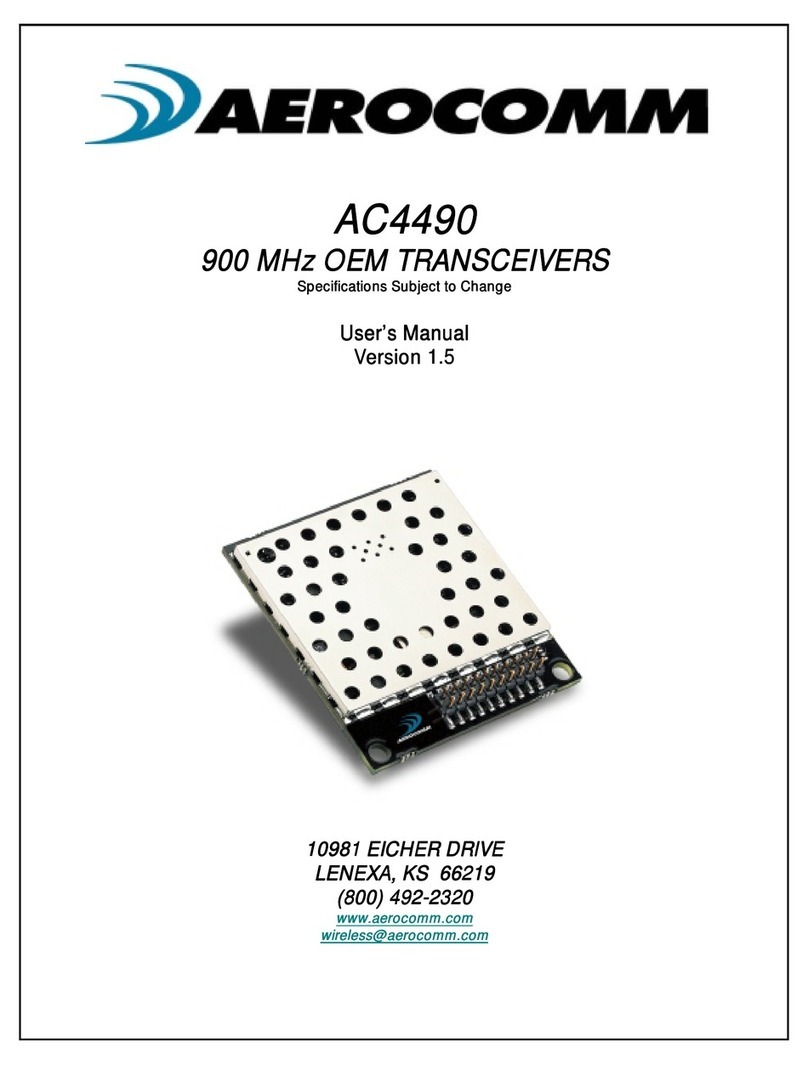
AeroComm
AeroComm AC4490 User manual

AeroComm
AeroComm AC4490 User manual
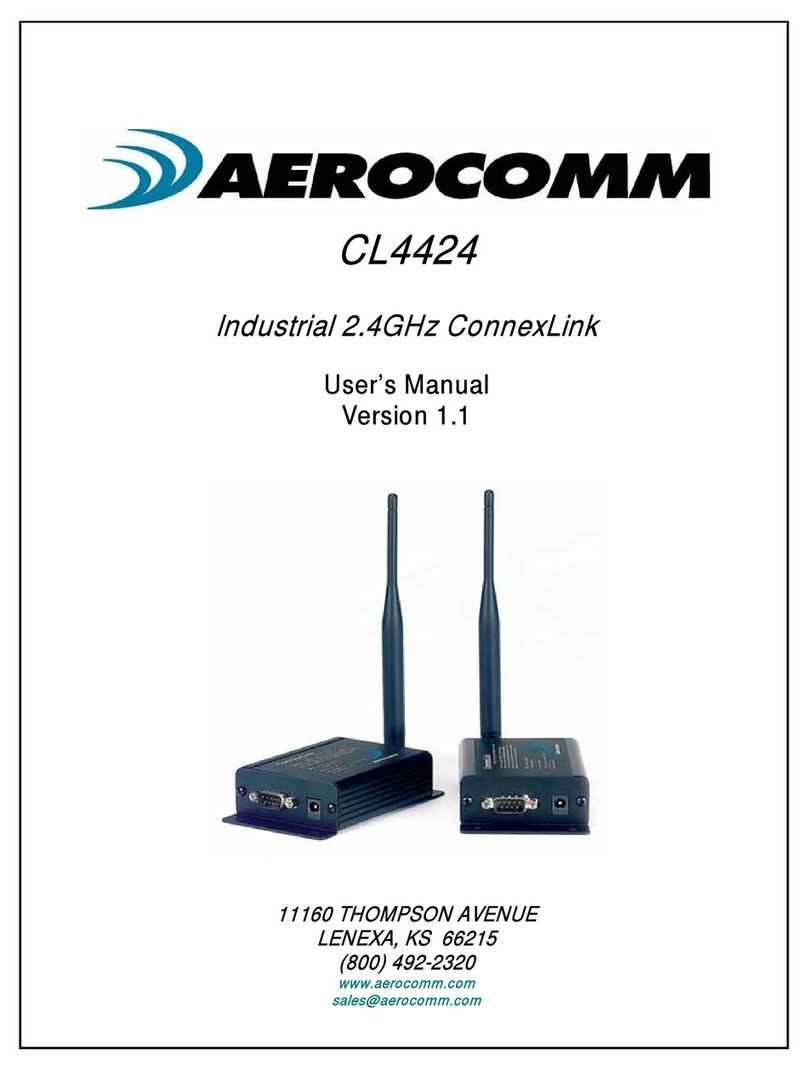
AeroComm
AeroComm CL4424 User manual
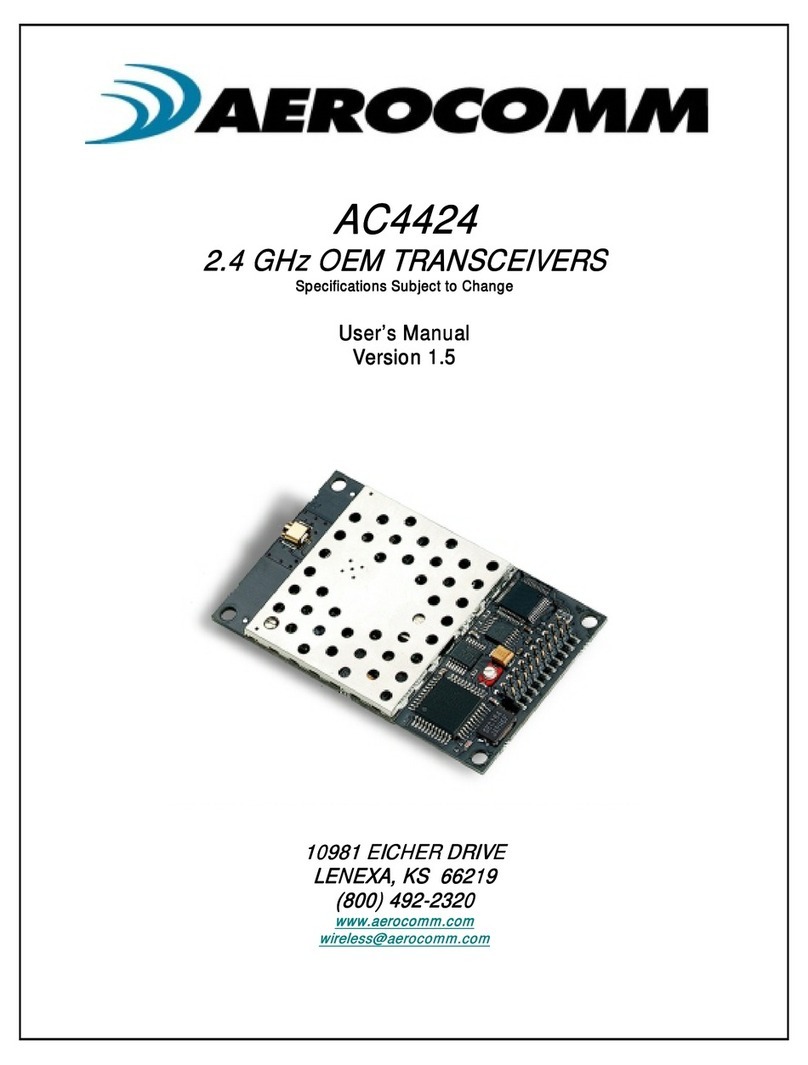
AeroComm
AeroComm AC4424-10 User manual

AeroComm
AeroComm CL4490-1000-485 User manual
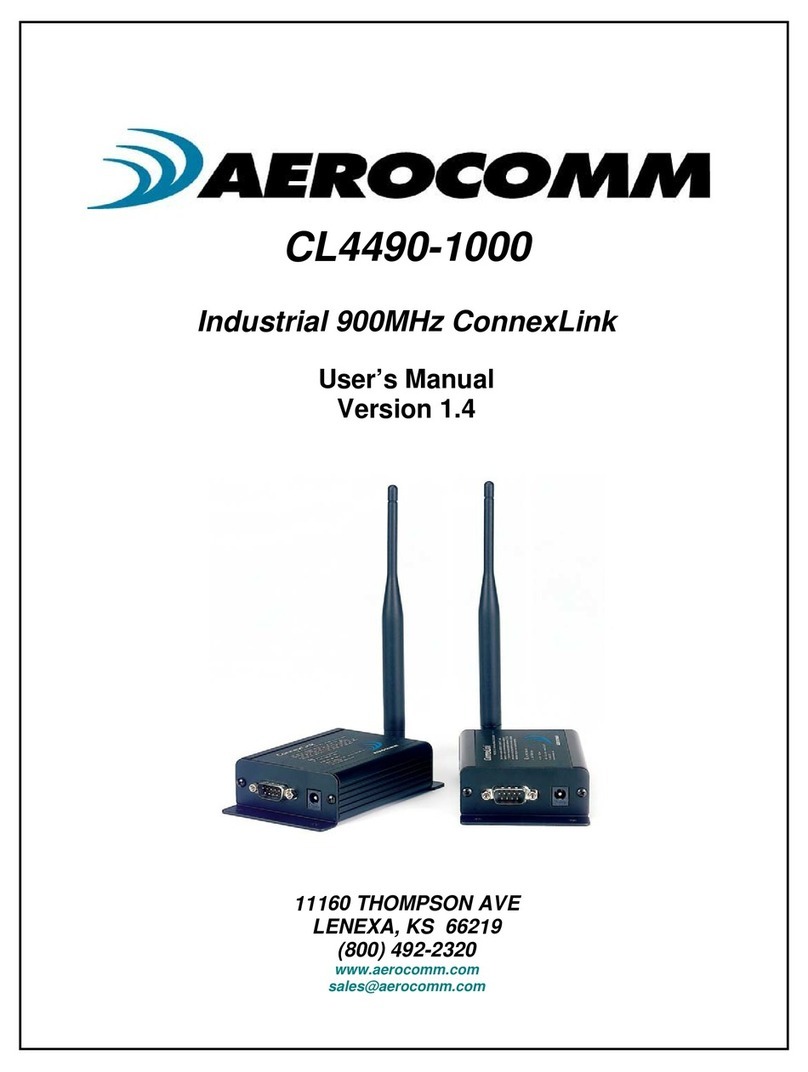
AeroComm
AeroComm CL4490-1000 User manual

AeroComm
AeroComm CL4490PRO User manual
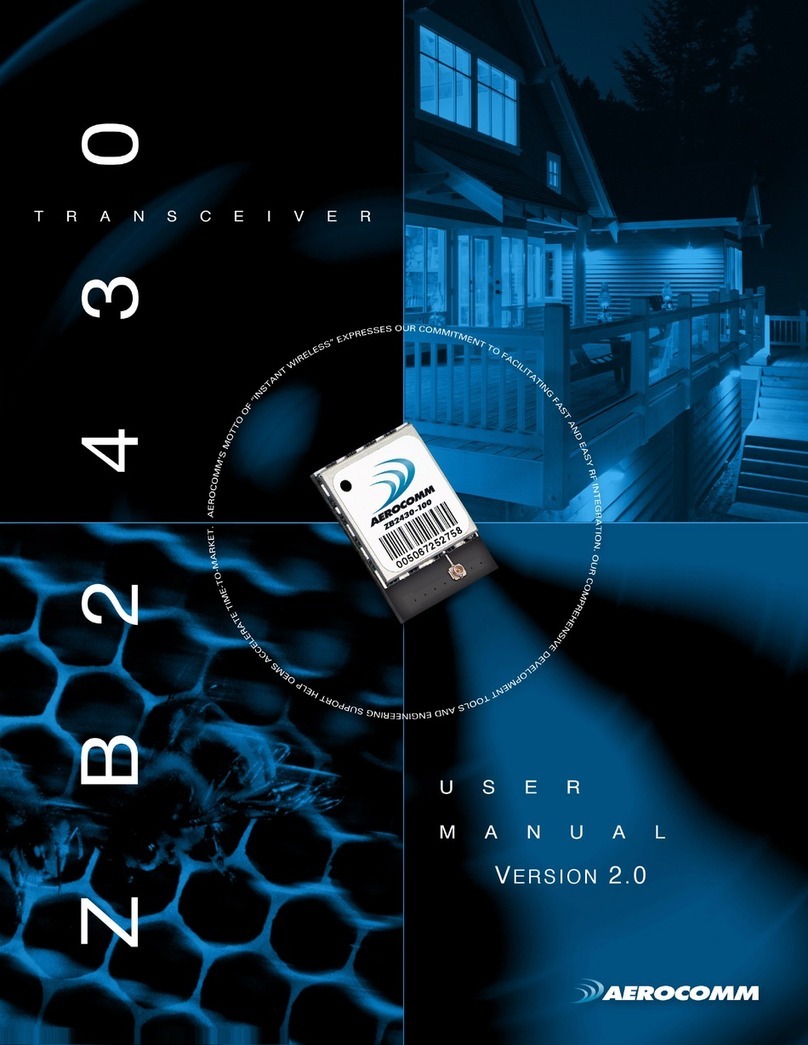
AeroComm
AeroComm TRANSCEIVER ZB2430 User manual
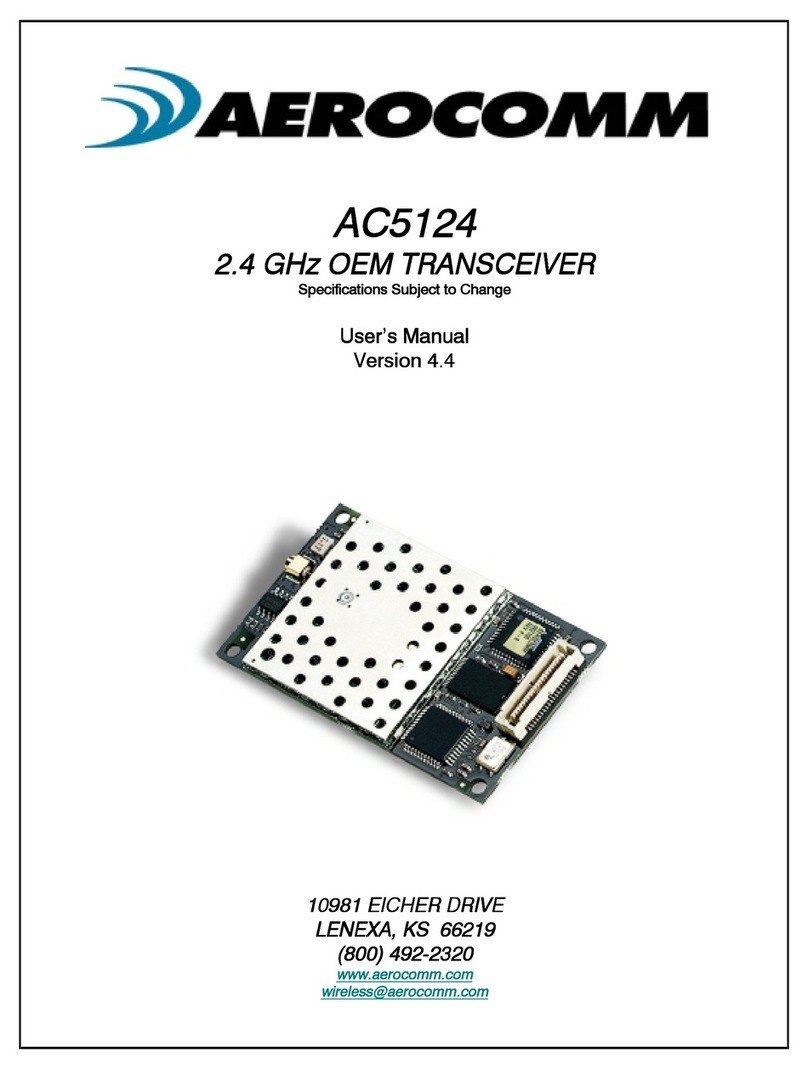
AeroComm
AeroComm AC5124 User manual
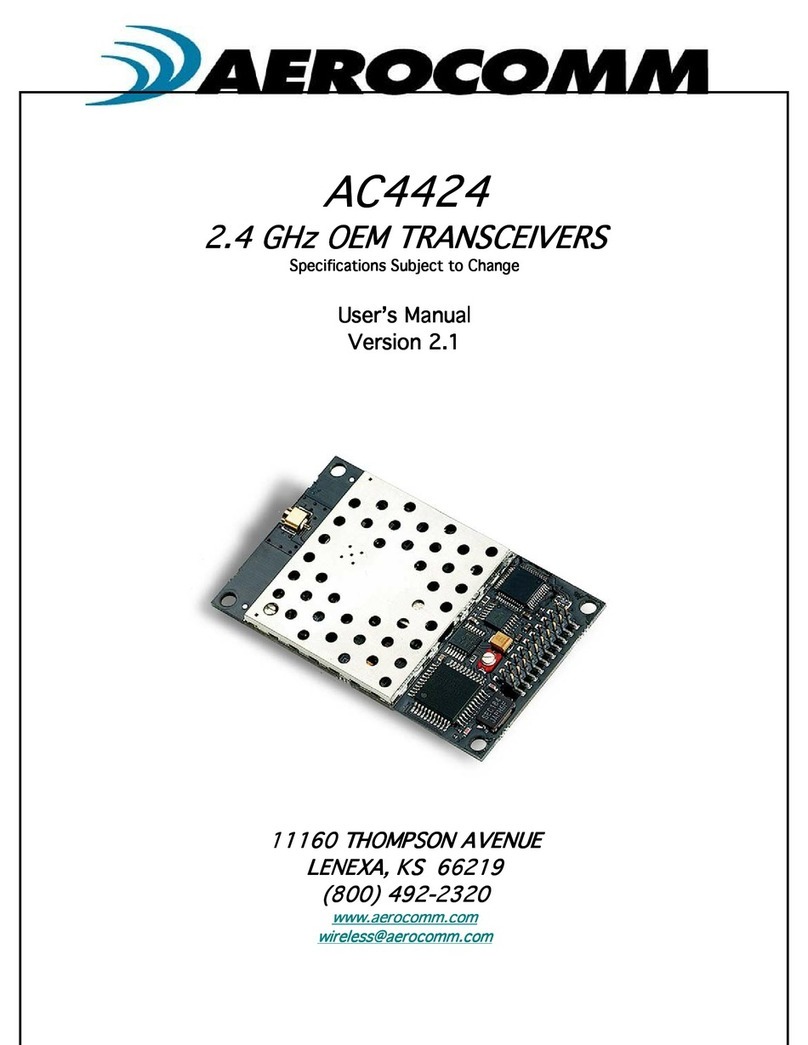
AeroComm
AeroComm AC4424 User manual



